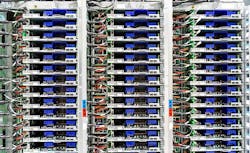Google Plans $1 Billion Data Center Expansion in Ohio Cloud Cluster
Google will invest an additional $1 billion in its data center operations in Central Ohio, expanding its campus in New Albany and acquiring land for future campuses in Columbus and Lancaster.
The investments represent more growth for the cloud cluster in the Columbus suburbs, which is home to large campuses for Google, Facebook and Amazon Web Services as well as commercial data centers from Cologix, Compass Datacenters, Iron Mountain and STACK Infrastructure.
Google broke ground on its New Albany data center in 2019, and has invested more than $600 million to data in the campus. In addition to adding capacity at its existing site in New Albany, Google has purchased 618 acres of property to build additional data centers, including 500 acres in Columbus and about 120 acres in Lancaster. The company now has more than 1,000 acres for data center development in Ohio.
With the expansion, Google will establish a Google Cloud Platform (GCP) region in Columbus, which will be the eighth in the U.S. and 28th globally. Cloud regions allow GCP users to specify the placement of their cloud infrastructure, enabling faster service in a given location
“We’re proud to be an Ohio company and excited about the opportunity to continue our growth in the state,” said Reginald Mcknight, Google’s Regional Head of External Affairs & Community Development. “With its business-friendly environment, central location, and skilled workforce, we’re excited to be part of the thriving community that is continuing to chart a new path for Ohio’s economy.”
“New Albany has seen the positive impact Google has on our local economy. We are thrilled to see Google continue to invest and grow in our community,“ said New Albany Mayor Sloan Spalding.
As the Internet cloud builders seek to distribute large files to support videos, gaming and virtual reality, the center of the country is proving to be the ideal place to add data center capacity. Placing data centers in places like Ohio and Iowa makes it easier to distribute content to major markets like Chicago and Dallas, reducing lag and buffering for streaming media like Netflix movies or Facebook videos. It also allows for data to move quickly to either coast, which can be important in application development.
The data center growth in New Albany began in 2014 with Compass Datacenters, which cited strong interest in the region from data center clients. Shortly after, Amazon Web Services built three campuses in the region, and Facebook placed a campus in New Albany. Among multi-tenant providers, the area has become a key hub for Cologix, which is deploying 70 megawatts of capacity in Columbus.
Google was an early pioneer in these data center hubs, which offer economies of scale, enabling companies to rapidly add server capacity and electric power as more workloads shift from in-house IT rooms into these massive server farms. It has become routine for hyperscale companies like Google to invest more than $1 billion in a single location where they place a cloud campus.
The scale of Google’s infrastructure is remarkable. Its cloud campuses house multiple buildings, each approximately twice the size of a Wal-Mart and filled with servers and storage to manage data. Google typically spends more than $1 billion to complete an entire campus, with some sites exceeding $2 billion in investment.
Google is on the bleeding edge of data center technology, customizing nearly every element of its operations, from processors to building design. Google has recently shifted to liquid cooling with its latest hardware for artificial intelligence, as the heat generated by its new Tensor Processing Units (TPUs) has exceeded the limits of its previous data center cooling solutions.
About the Author



